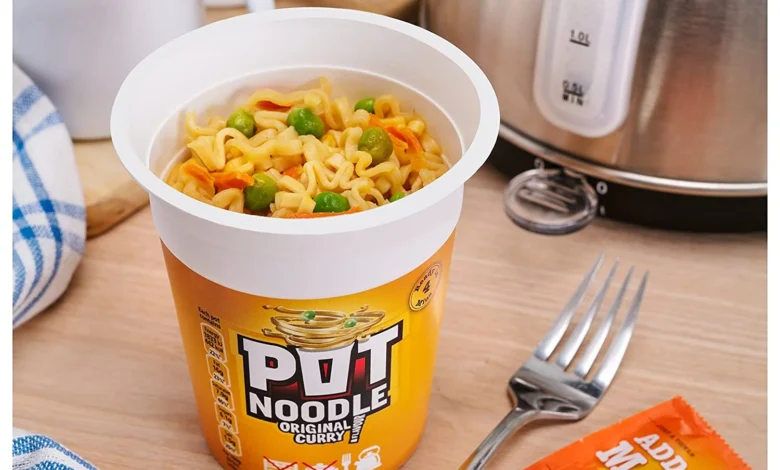The Evolution and Popularity of Pot Noodle

Pot Noodle has carved a unique niche in the global food market, becoming a cultural icon and a go-to meal for millions. Its history, convenience, and cultural significance make it a fascinating case study in modern food innovation. This article explores the origins, evolution, and widespread appeal of Pot Noodle, shedding light on why it remains a staple for people seeking quick and easy meals.
A Brief History of Pot Noodle
The Pot Noodle brand was introduced in the United Kingdom in 1977 by Golden Wonder, inspired by the Japanese instant noodle phenomenon. Invented by Momofuku Ando in the 1950s, instant noodles revolutionized quick meals, providing a convenient, long-lasting food option. Pot Noodle took this concept and adapted it for Western markets, packaging the noodles in a distinctive plastic pot with dehydrated vegetables, seasonings, and optional sauces. This format allowed consumers to prepare a hot, satisfying meal by simply adding boiling water.
Golden Wonder eventually sold the brand to Unilever in 1995, marking a new era for Pot Noodle. Under Unilever’s stewardship, the brand expanded its flavor range, marketing campaigns, and global reach, solidifying its status as a cultural phenomenon.
Convenience Redefined
One of the key factors behind Pot Noodle’s enduring popularity is its unparalleled convenience. With a preparation time of just a few minutes, it caters to the modern consumer’s fast-paced lifestyle. Whether you’re a student pulling an all-nighter, a busy professional seeking a quick lunch, or someone craving a late-night snack, Pot Noodle provides an easy solution.
The product’s portability also adds to its appeal. Unlike traditional cooking methods that require multiple utensils and appliances, Pot Noodle’s self-contained design makes it an ideal choice for on-the-go meals. This simplicity has made it particularly popular among students, travelers, and office workers.
Flavor Innovation and Variety
Pot Noodle’s success can also be attributed to its diverse range of flavors, catering to a broad spectrum of tastes. Classic options like Chicken & Mushroom, Beef & Tomato, and Bombay Bad Boy remain fan favorites, while newer offerings continue to push the boundaries of flavor innovation. Limited-edition flavors and seasonal releases keep the product line fresh and exciting, ensuring that even loyal customers have something new to try.
The brand has also embraced global culinary trends, introducing flavors inspired by international cuisines such as Thai Green Curry and Japanese Teriyaki. This approach not only broadens its appeal but also positions Pot Noodle as a product that evolves with changing consumer preferences.
Marketing Genius
Pot Noodle’s marketing campaigns have played a significant role in cementing its place in popular culture. Known for their humor and irreverence, these campaigns resonate particularly well with younger audiences. Slogans like “The Slag of All Snacks” and commercials featuring quirky, relatable scenarios have helped Pot Noodle stand out in a crowded market.
The brand’s ability to poke fun at itself has further endeared it to consumers. By embracing its status as a “guilty pleasure” and leaning into its reputation for being a quick, unpretentious meal, Pot Noodle has created a unique and authentic brand identity.
Cultural Impact
Over the decades, Pot Noodle has transcended its status as a mere food product to become a cultural touchstone. In the UK, it is often associated with student life, late-night cravings, and nostalgia. Its affordability and convenience make it a rite of passage for many young people living away from home for the first time.
Pot Noodle’s influence isn’t confined to the UK. The product has gained a loyal following in other markets, adapting its flavors and marketing strategies to suit local tastes. In some countries, it is even considered a gourmet snack, highlighting its versatility and broad appeal.
Environmental Considerations
As consumer awareness of environmental issues grows, Pot Noodle has taken steps to address sustainability. Unilever has committed to reducing the brand’s environmental footprint by adopting recyclable packaging and sourcing ingredients responsibly. While there is still room for improvement, these efforts demonstrate the brand’s commitment to aligning with modern values.
Criticisms and Challenges
Despite its popularity, Noodles has faced its share of criticisms. Some detractors point to its high sodium content, artificial ingredients, and lack of nutritional value, arguing that it promotes unhealthy eating habits. However, the brand has responded by introducing healthier options, such as low-fat and vegan varieties, to cater to health-conscious consumers.
Additionally, Pot Noodle competes in a crowded market of instant meals and snacks. Brands like Cup Noodles, Ramen, and supermarket own-label options offer stiff competition. To maintain its edge, Pot Noodle must continue innovating and addressing consumer demands for healthier, more sustainable products.
The Future of Pot Noodle
As we look to the future, Pot Noodle’s adaptability will be key to its continued success. By leveraging trends such as plant-based eating, global flavors, and eco-friendly packaging, the brand can stay relevant in an ever-changing market. Collaborations with chefs, influencers, and food enthusiasts could also help elevate its profile and attract new audiences.
Technological advancements may offer additional opportunities for innovation. For instance, smart packaging that interacts with smartphones or customized flavor packs could enhance the consumer experience. These innovations, combined with the brand’s strong legacy, position Pot Noodle for sustained growth.
Conclusion
Pot Noodle is more than just a convenient meal; it’s a cultural icon that has stood the test of time. From its humble beginnings to its current status as a global phenomenon, it embodies the spirit of innovation and adaptability. While it faces challenges in an increasingly health-conscious and environmentally aware world, its ability to evolve and connect with consumers ensures that it will remain a beloved staple for years to come.





